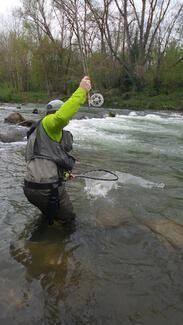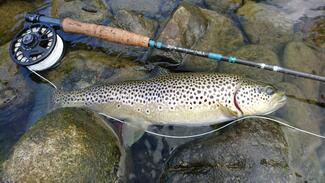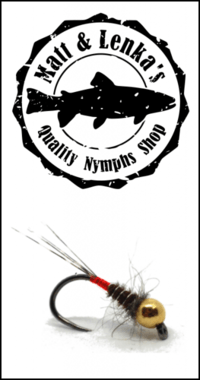When we are looking for big salmonids, the gear must not be overlooked because it will be hardly solicited during long fights. Every fisherman must perfectly know its gear in order to be ready for those explosive fights. When we are hooked to a very solid fish, every detail is important and often count to define the end of the story. We all have taken or at least been hooked with a big trout by accident, with definitely not adapted gear. When it makes a happy end, the fly fisherman ego is often flattered, but generally, better not try the impossible. Power and weight of the big trout never forgive gear selection mistakes.
Gear for big trout: a matter of choice
During talks with other fishermen, we understand the differences of opinion that everyone can have regarding the fishing gear. Convictions and arguments being the source of multiple exciting conversations and debates. Some only trust heavy gear, when others don’t hesitate to fight 24” trout on a weight 3 rod and very fine tippet.
The gear that you trust, that brings you confidence and security, will always be the one you will need to use if you decide to look for the fish of your life. Specimen hunting requires to only use gear that you are familiar with in order to avoid bad surprises. Every element will constitute the golden thread you won’t break, from the smallest accessory to the rod/reel combo. Learn to feel its gear working is very important. Know the limits of every element, their breaking point and their behaviour in extreme conditions is at least as important. That implies to not change gear every other day.
Considering the environment where you fish
Beyond the size of the coveted fish, the choice of the gear will depend of the type of water you are fishing. The river profile, power of the current and other snags will need to be considered in order to pick the right gear. Indeed, a big trout hooked in a slow and deep pool without any source of snag, will offer a much easier fight than another one hooked in the middle of roots, between two logs. For those multiple reasons, I will tell you about my convictions and the gear that are essential to me. Some might find themselves in this speech, others will have a different opinion, there is no absolute truth.
The gear I will describe is what I use to fish lower sections of the Pyrenean rivers. It is intended to fish trout between 50 and 75 cm (20 to 30”). They are bigger fish ion some rivers, but they are unfortunately too rare to be spoken of here.

Gear for big trout: the rod
If you are looking for big trout, a versatile rod is an option. It allows to fish with a dry fly or a nymph. Personally, I rather use a rod for each technique when it is possible. I already hear comments like “why would you obstruct yourself like that?”. I don’t deny the troubles when carrying two rods, but I only found advantages to have one for each technique. Carrying two rods allows to quickly adapt to the right method in front of big fish rising or nymphing for a very short period of time.
Generally speaking, I prefer models with fighting butt because they offer a comfort much appreciated during battles. It allows to rest the forearm on which a lot of tension is accumulated. It is often not the fish power that exhausts our arm, but the stress of the angler itself.
Specific rods for this approach will need to have an exemplary capacity to hold the fish but they will also need to keep some softness to avoid the line to break during violent rush. On the top of all that, the rod needs to be able to present quickly and accurately your fly to a rising trout. To stay stealth, you’ll need to do as few false casts as possible. It is very important considering big fish are educated and used to fishermen.
For dry fly fishing, I use a fast rod. A 9’ #5 the G-Loomis NRX (Editor’s note: the CSS protocol measure for this model is ERN 5.94 and AA 66°). In the case of very heavy fishing, I use a longer and more powerful model, the Sage One 9’6 #6 but those situations are very rare.
I often use the 9’ because of its versatility and allowance of fluidity and comfort. Despite everything, it stays efficient and performs very well whatever the environment of the spot. The rod must become the natural extension of the arm. Behind a big trout, managing emotions involve to forget the gear and the different conditions around you to only think about the incoming battle that will take place. To stay discreet, you’ll want to pick a rod with a dull blank and not very bright rings. Any shine can spook a trout.
For nymphing, I recommend using a 10’ #4/5 or #5. I have been using the Greys GR70 10’ #5 and I am very happy with it. It is soft enough to practise Euro nymphing (Spanish style) and has an excellent value for money. My favourite action for nymphing is moderate fast. The extra length will allow a better line driving during the drift and the #5 power will grant a good capacity to hold the fish (Editor’s note: this rod has been measured with CSS and the ERN is 4.90 and AA 65°).
Gear for big trout: the reel
On finer fishing technique, the reel is just a stock of line, but it becomes an essential element when big fights are involved. It is mostly the brake’s quality that will determine the choice of the model. It will need to be progressive and able to put up with unpredicted rush.
Nowdays, most reels have those caracteristics. We will then pick a model that has a big enough and accessible brake’s scroll wheel. The line capacity will need to accept some baking and your fly line for the day a big fish will try to empty your reel. As for the rod, I suggest to avoid too shiny models and prefer large arbor with faster recuperation. I am a fervent unconditional of the reels from the brand Nautilus which offer all those qualities and a rock-solid reliability.

Gear for big trout: the fly line
The choice of the fly line profile will need to take in account the action of the rod you are using and your own preferences in this matter. Personally, I prefer WT and Triangle Taper lines because they quickly load the fast action rods I use. This kind of fly line makes roll cast and mend easier, but still allow a stealth and delicate presentation. The weight will need to be chosen according to your rod real power.
Gear for big trout: the tippet line
In this article, I will only talk about the line I use for my tippet. Superior sections are less important and cause less troubles because they are much wider. To link them, the famous blood or barrel knot is a solid value.
For the tippet, I use nylon or fluorocarbon according to the conditions. The diameter may change from 12/100 (6X or 2 lbs) to 16/100 (4X or 4 lbs). Every fishing situation needs us to adapt and use the right line.
Fluorocarbon will be used for dry fly fishing or when using an emerger, when traditional nylon is too easily to spot for the educated trout on the surface. For fine nymphing, I also use fluorocarbon. I definitely trust the brand Trouthunter, their product never disappointed me until now.
At the beginning of the season, when the water level is high and the fight can be tough, I like to use the nylon Stroft GTM (14 or 16/100). The real diameter is much wider than announced, but it offers a real solid ration resistance/diameter. I trust it since I began fly fishing a long time ago.
Some big trout particularly educated and suspicious enquire to use very fine tippet, which makes the fight to last long and can cause disastrous consequences on the fish itself. It happens to me to use 12 or 10/100 (6 or 7X). It is mostly the case during the summer period, when water level is low and temperature high. With respect for the fish, try not to make the fight too long during this period. Catch a very big trout several times is always a very special emotion.
Gear for big trout: the hooks
Whatever the shape, they will firstly need to be adapted to fly fishing in order to obtain the volume and shape desired. When it’s possible, I try to choose strong hooks so it limits unhooked fish and opening during violent fights. Barbless or not, it is a matter of choice and a topic that opens debate. It took me a while before using only barbless references but I do now. From my experience, there isn’t more unhooked fish with a barbless hook as long as you keep your line in tension. The two references I use the most in my hunt for big trout are the Kamasan B405 for the straight shape and the Caleri C23 for the curved.
Gear for big trout: the landing net
The net is an element that is often neglected and responsible of many frustrations… Who never experienced a net too small to land a very nice trout? I will never forget this trout made my net look like a ridiculous frying pan before heading back to its element with an ultimate, fateful, rush. Even if it can look snooty, better use a very large model optimising the landing of the trout and shorten the fight duration. The net will need to be soft and preserve salmonid’s mucus to favour safe release. I use a very reliable model, simple and light, the JMC x60 measuring 40 x 54 x 73 cm.
Other elements of the equipment have indeed their significance: the fly fisherman clothes have their role to play during the approach, as well as the shine of the rod and reel. The more you are discreet the better. A fly vest well organized and waterproof waders bring you the comfort you need to stay focus when the action comes. Don’t forget that gear selection stays personal and that something making your fishing partner happy will not necessarily suit you.
RELATED ARTICLES:

